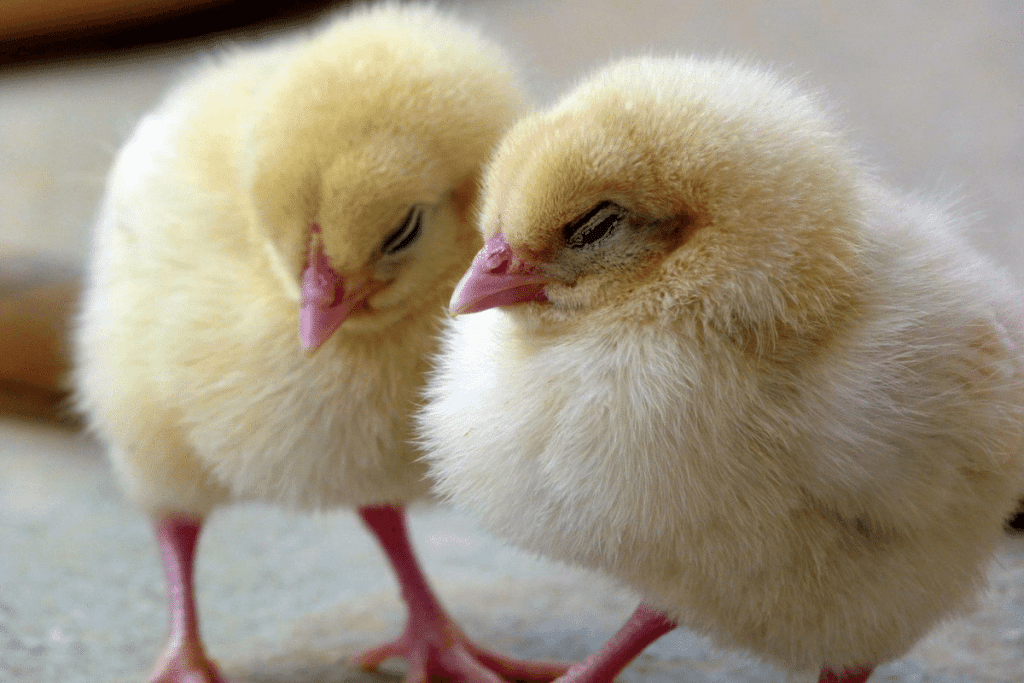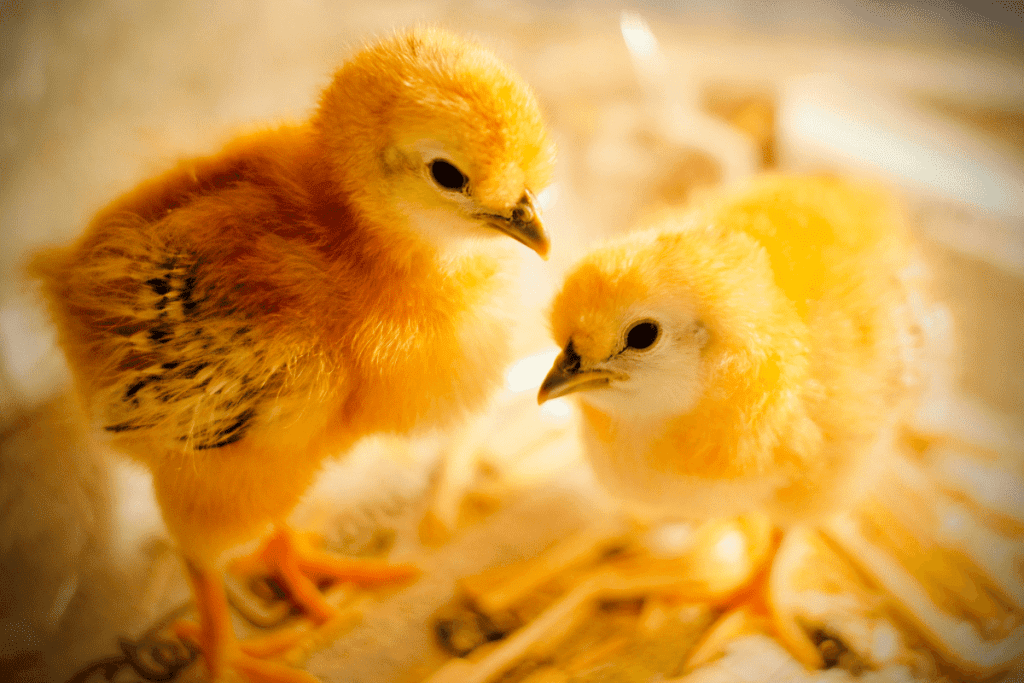If you have just picked up your first new batch of baby chickens, you might have many questions that need answering.
After all, these little feathered balls of cuteness require a whole different type of care than their fully-grown counterparts.
This is where this guide to baby chickens for farmers comes in.
We’ll cover answers to many of the commonly asked questions for you, all in one place.
Read on to find answers to these questions and more.

Table of Contents
ToggleWhat Are Baby Chickens Called?
Baby chickens are most often called “chicks,” which is a name for chickens when they are young. Baby chickens are called chicks until they are old enough to be sexed, at which point they are called “pullets” for females or “cockerels” for males.
Sometimes, baby chickens are called “peeps,” especially if they are a flock of chicks.
This is a more colloquial term for baby chickens.
How Are Chickens Born?
Chickens are not exactly born; instead, their mother lays an egg they hatch out of after developing inside the egg. It takes up to three weeks for a chicken to develop inside its egg.
A laying hen has two ovaries, only one of which is active.
This active ovary holds many ova, egg yolks waiting to develop.
When it is ready to turn into an egg, the egg yolk moves through the oviduct, which is a tube where eggs are built.
The first part of the oviduct is called the magnum, where egg white protein gets added to the egg yolk.
This protein feeds and protects the chick as it grows inside the egg.
After the egg white is added to the egg yolk, the entire bundle enters the shell gland.
This area is where layers of calcium carbonate are added slowly over about 20 hours to create the eggshell.
The pigment of the shell is deposited in the last two hours or so of the shell formation.
After the shell has been created, the egg is laid out of the mother chicken’s oviduct.
After it is laid, the chick develops within the egg for about three weeks, at which point it hatches out of the egg and is called a chick.
How Long Does it Take for a Chicken to Grow Up?
Chickens are typically considered adults once they reach sexual maturity, meaning they have begun laying eggs. This can happen anywhere between 16 and 24 weeks of age but typically happens around week 18.
Once fully grown, chickens can typically live for up to 10 years.
When Can Chicks Go Outside Without a Heat Lamp?

Chicks must have all of their feathers before they go outside, usually anywhere from 6-10 weeks of age. Before this age, chicks must be kept close to a heat source because they have trouble regulating their body temperature.
How Long Do You Need a Heat Lamp with Chicks?
Chicks need a heat lamp for about 4-6 weeks before they can survive without it. Chicks need additional heat because they cannot keep themselves warm enough and require an alternative heat source. Adequate heat is a must when raising chicks to help them keep their body heat stable.
What Temperature Can Chicks Go Outside?
For chicks to go outside safely, temperatures must be at least 65° degrees Fahrenheit (18° C). Keeping baby chicks warm is an essential part of keeping your chicks alive.
What is the Best Temperature for Chicks?
Chicks that have just hatched from their eggs need to be kept at about 95° degrees Fahrenheit (35° C) for the first week of their life. Keeping chicks at the correct temperature is essential for their health.
After the first week of their life, chicks are kept at 90° degrees Fahrenheit (32° C), and at two weeks are kept at 85° degrees Fahrenheit (29° C).
With each week of their life, they are kept at a temperature five degrees lower than the previous week.
Why Do Chicks Need to be Warm?
All living organisms need warmth, and a flock of chicks is no different. Keeping a box at the correct temperature for baby chicks is essential to keeping them alive and healthy.
Because baby chicks do not have feathers and are warm-blooded, an essential part of the care of chicks is keeping them warm.
Usually, chicks depend on their mothers for warmth, but when humans keep them in a box away from their mothers, they must be kept warm by radiant heat.
Are Heat Lamps Dangerous for Chicks?
A traditional 250W heat lamp is quite dangerous for chick health, and it is worth looking into other options for keeping your box of chicks warm. They are fire hazards and often dehydrate the chicks if too powerful.
The first danger of heat lamps is simply: they are fire hazards.
They can get so hot any flammable object touching them (such as feathers) can burst into flames and cause a fire.
Additionally, heat lamps do not allow chicks to regulate their own need for heat, making them develop slower.
The ability to move away from the heat source is an essential behavior of chicks and must not be impaired.
Chicks need to be able to spend time away from their heat source so they can develop properly.
This EcoGlow brooder is an excellent choice for keeping chicks warm, as it allows them to access the warmth whenever they need it and leaves them free to leave the heat when they are finished with it.
There are many other alternatives to brooder heat lamps, and all of these alternatives should be investigated before choosing a traditional heat lamp.
Learn how long chickens can go without water before getting dehydrated.
Do Baby Chicks Need Light at Night?
Chicks need some light at night to navigate around their pen and find their food and water. While they do not need full sunlight, they need a little bit of light just to help them move around safely.
Chickens have bad night vision, so they will struggle to move around effectively without night lights.
Where Do You Buy Chicks?

It is possible to buy chicks as early as one day old, having just hatched from their eggs. One can purchase them directly from a hatchery or your local farm supply store, such as Tractor Supply.
Most farm supply stores order chicks once or twice a year in the spring, so they will have live baby chicks for purchasing.
It is also possible to purchase chicks directly from local farmers if you live in an area with many farms.
Where there is local chicken meat to buy, there are chicks out there.
Where Do You Keep Chicks?
Keep chicks in a cardboard box, a small fenced-off section of an empty chicken coop, or wherever they cannot escape from. There should be enough space in your chicks’ home to move around and for their feeder and waterer.
It is vital to note chicks shouldn’t be housed alongside older hens or roosters, so if you already have chickens in your coop, you’ll need a separate space for your chicks.
Chicks cannot be introduced to older birds until they are at least 12 weeks old because they need to be safe as the new pecking order is developed.
Use pine shavings for bedding for the chicks, spreading the pine shavings about 4″ inches thick on the ground.
Then, add a layer of newspaper to the pine shavings in the cardboard box or chicken coop.
The space where you keep your chicks should ideally be round or have wide angles without small corners so the chicks cannot bunch up and suffocate each other.
Additionally, any light in the area should be red rather than white, as red light disguises injury on the chicks and discourages them from pecking at each other.
What Do Chicks Eat?
Chicks are typically fed chicken starter feed, containing at least 18% protein. Chicks need large amounts of protein to fuel their growing bodies.
Place the feed on a flat piece of paper or directly onto the newspaper you laid down in your chicks’ home.
On your chicks’ second day, put a chick feeder in the pen so they can learn to feed from a real feeder.
The food in the feeder should be changed every day, so it does not get moldy or go bad.
If their food goes bad, it could make your chicks sick to their stomachs.
What Do Chicks Drink?
Chicks need plenty of fresh water to live a healthy life. Use any regular chick waterer to provide water for your chicks, or even build your own. The waterer should be shallow enough the chicks cannot drown in it, and the water should be changed out every day.
Chicks like to drink room temperature water, not ice water or hot water.
Chicks will willingly drink milk, but they do not need to be healthy.
How Many Chicks Should You Buy?
Chicks are social birds and do not do very well when living by themselves. For this reason, two or three chicks are a good number to purchase if you do not want a full flock of chickens but want to have a few to lay eggs for your family.
If you want eggs to give away to your neighbors or you have a larger family, purchase more than four birds.
Why Are Some Chicks Yellow and Some Are Not?
Not all chicks are yellow, and it’s their genetics which causes the variations. Many are yellow, but it’s also common to see brown, black, and white chicks when they first hatch from the egg.
Most chicks who are yellow when they hatch will grow up to be yellow or white adult birds.
The reason for the coloring differences is largely genetic.
Genetics determine the coloring of any living organism, and chicks are no different.
What Determines the Color of Baby Chicks?
There are only two pigments within chicken genetics: red and black. All of the chicken colors are made up of these two pigments. Genetics determine how much of each pigment is present in a chick’s feathers.
Male chickens typically have brighter feathers than females because males need to attract females while females need to be camouflaged while sitting on their eggs.
How to Tell What Kind of Baby Chicken You Have
Identifying what type of chick you have is difficult, especially when the chicks are very young. The easiest way to identify chicks is to look up a photo guide to different types of chicks and compare your chicks to the photos.
There are many breeds of chicken, and they don’t all look distinct from each other when they are young.
It is possible to identify chicks based on their coloring and markings, especially markings around the eyes.
Additionally, look at their legs to see if they are furry or clean.
Another option is to wait until your chicks grow older and are easier to identify.
When To Move Chicks from Brooder to Coop
If temperatures outside are regularly above 65° degrees Fahrenheit (18° C) and your chicks are older than 6 weeks, they can move into the chicken coop. But if there are adult chickens in the coop, you need to wait until the chicks are at least 12 weeks old before adding them to your existing flock.
Chickens need plenty of time to get used to each other and establish a new pecking order when members of the flock are added or removed.
When you introduce new chicks to a flock, there will be plenty of squawking, flapping, and pecking as the chickens organize themselves according to dominance.
Most of this activity is normal and no cause for concern unless you see blood or injured chickens.
How useful was this post?
Click on a star to rate it!
We are sorry that this post was not useful for you!
Let us improve this post!
Tell us how we can improve this post?
